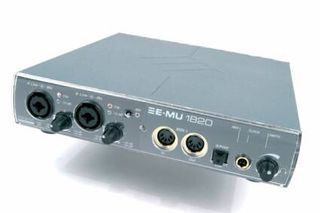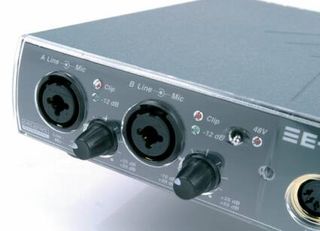Creative's E-MU 1820 Goes Home Studio Pro
A Pro Tool


AudioDock makes a good impression from the start. It is professional looking and has a sleek design. The front left hand side has two micro-line input channels with adjustable gain. Input signals enter the card via two combined jack/XLR sockets, the jack being associated at line level with the card (or with a high impedance instrument) and the XLR at microphone level. We are rather skeptical about this arrangement. It would make more sense to have a switch that the buyer could wire to the connectors in their preferred configuration. A switch would also enable the use of phantom (48 V) power for mikes. This implementation is common to both inputs. Yet each channel has its own gain control and its own indicators indicating the presence of an overload signal. The preamps are provided by TF Pro, a studio hardware manufacturer which guarantees a much higher quality of service than on your average sound card with mike preamplification. The right-hand side of the front displays two standard MIDI (I/O) sockets, an optical S/P DIF output and a headphone socket on a 6.35 mm jack combined with a potentiometer for adjusting the levels. A small indicator panel provides a readout for various components such as sampling frequency for the digital section.

At the back, there are a number of 6.35" 'stereo' jacks on a baseplate (for a symmetrical link), offering six additional inputs and eight outputs. There is also a phono input on a cinch base (with a separate ground), thus providing RIAA correction for a direct connection to a vinyl turnable with a cell containing a mobile magnet. This input is split between 3L and 3R input channels. Plugging in the connectors deactivates the phono input. What's even stranger is that there is also a series of 3.5 mm stereo jacks on a baseplate, asymmetrically doubling the symmetrical outputs. Naturally, this would make it easier to hook up the equipment to a public address system but it's still pretty surprising to find this type of connection here, even if it's useful for compatibility. (Creative explained that they are meant for entry-level and/or THX-approved surround speakers, therefore allowing people dip their toes in the water without having to refinance their homes.) Finally, there are two standard DIN sockets, offering a second MIDI link.
Stay on the Cutting Edge
Join the experts who read Tom's Hardware for the inside track on enthusiast PC tech news — and have for over 25 years. We'll send breaking news and in-depth reviews of CPUs, GPUs, AI, maker hardware and more straight to your inbox.
Most Popular

